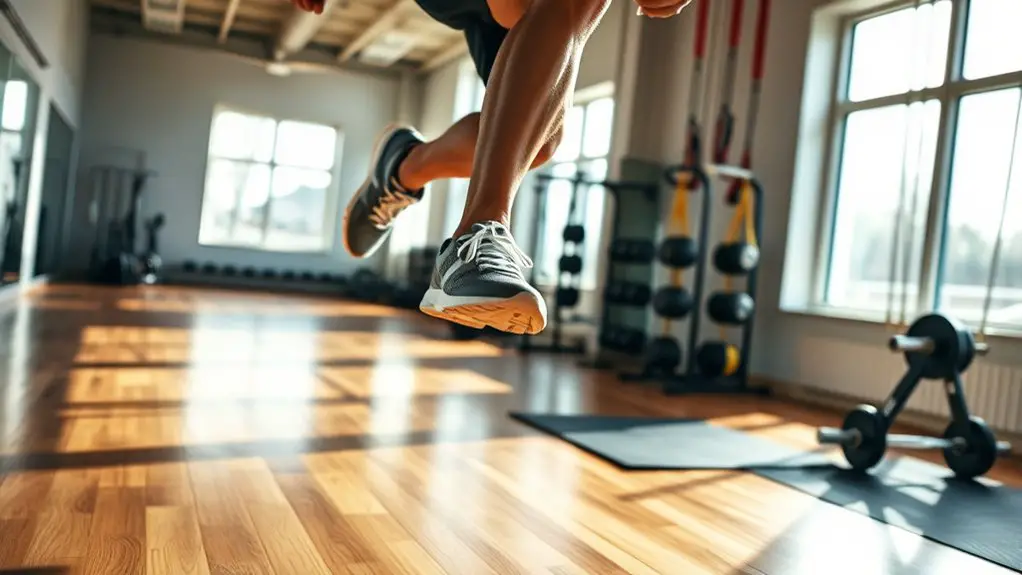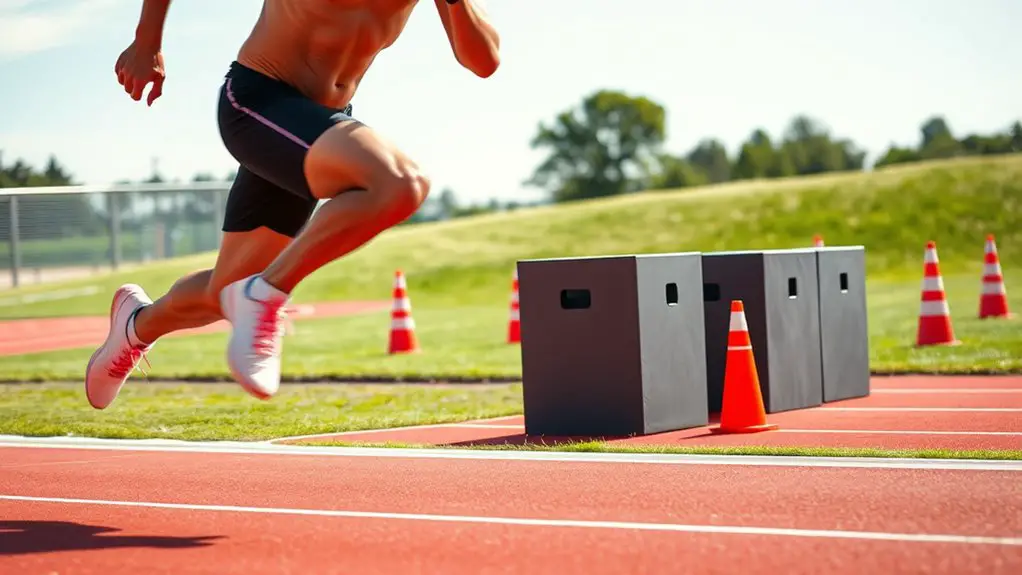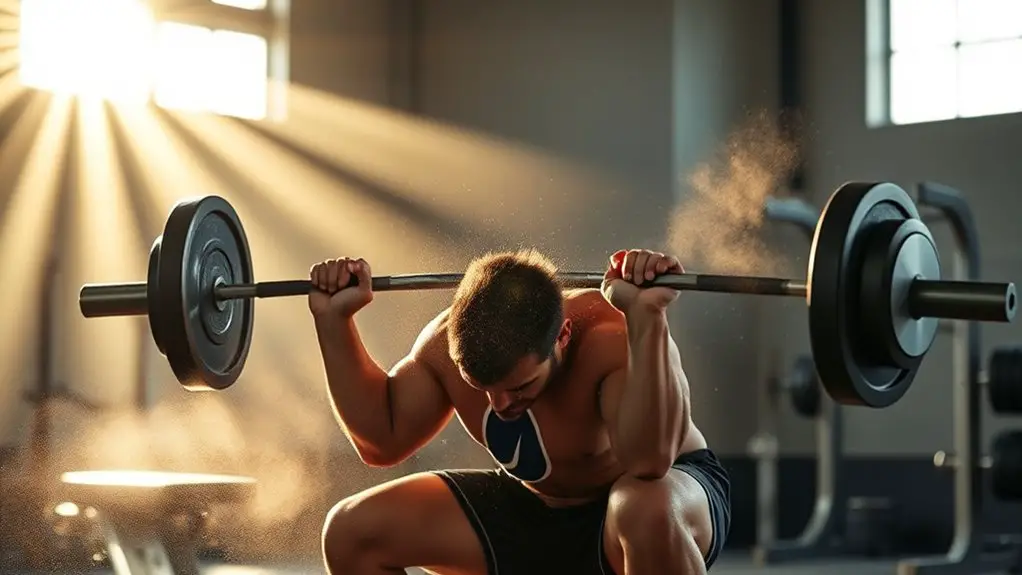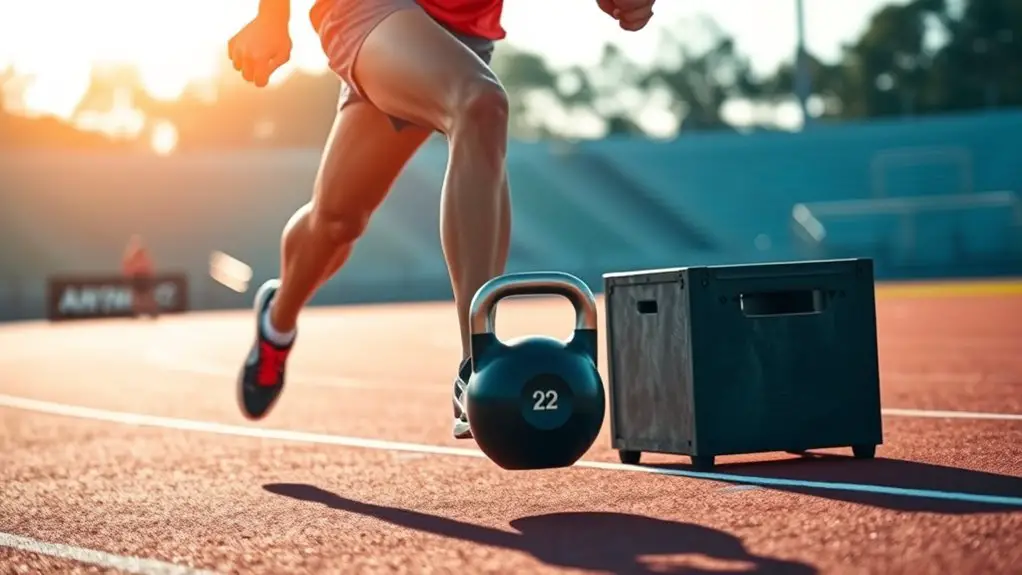Strength training plays an essential role in boosting your vertical jump height. By developing explosive strength and improving muscle power, you enhance your jumping ability considerably. Exercises like plyometrics and resistance training activate fast-twitch muscle fibers, leading to greater force application and higher jumps. You'll also experience physiological changes that improve coordination and efficiency. If you're curious about the best types of exercises and programming for ideal gains, there's more to uncover on this topic.
Understanding Vertical Jump Mechanics
When you think about vertical jump mechanics, it's essential to understand how your body moves during the jump. The essence lies in jump biomechanics, which involves the coordination of your muscles, joints, and limbs. As you prepare to leap, your body loads energy through a quick downward motion, storing it like a coiled spring. This is where force application comes into play; the stronger your muscles, the more force you can exert upward.
As you explode off the ground, your arms swing upward, helping to propel you higher. Your knees bend and extend in a synchronized motion, ensuring peak power transfer. Every detail matters—from your foot placement to the angle of your jump—each element contributes to maximizing your height. By mastering these mechanics, you're not just jumping; you're embracing the freedom of movement and releasing your potential. Plyometric exercises are a crucial component of training that can further enhance your vertical jump. Understanding these principles is your first step toward soaring heights.
The Role of Strength in Athletic Performance
Strength is a cornerstone of athletic performance, influencing everything from speed to endurance. When you think about your goals, whether it's jumping higher or running faster, strength plays a critical role. Developing explosive strength can enhance your ability to generate quick, powerful movements, giving you an edge during competitions. Moreover, strength endurance is equally important, as it allows you to maintain peak performance over time. Picture yourself in a game, pushing through fatigue—your strength endurance keeps you going when others falter. Additionally, incorporating plyometric exercises into your training can significantly improve your explosive strength and overall athletic performance.
Physiological Changes From Strength Training
When you engage in strength training, your body undergoes several key physiological changes that can enhance your vertical jump. You'll notice muscle hypertrophy, which increases muscle size and strength, as well as neuromuscular adaptations that improve coordination and efficiency. These changes lead to a significant boost in power output, translating to higher jumps and better athletic performance. Additionally, strong quads are essential for explosive movements like vertical jumps, supporting powerful leg extensions during takeoff.
Muscle Hypertrophy Effects
Although many factors contribute to athletic performance, muscle hypertrophy plays an essential role in enhancing vertical jump height. When you focus on strength training, you're stimulating muscle growth, which directly impacts your ability to jump higher. By increasing your training frequency, you'll promote more muscle fibers to adapt and grow, leading to greater power output during explosive movements like jumping. This process not only boosts your vertical leap but also improves your overall strength and endurance. Consistency is key; the more regularly you train, the more significant the changes you'll see in your muscles. Embracing this journey of muscle hypertrophy empowers you to break through your limits and achieve the freedom of your athletic potential.
Neuromuscular Adaptations Explained
As you engage in strength training, your body undergoes significant neuromuscular adaptations that enhance your performance, particularly in activities like jumping. One of the key changes is improved neural efficiency, where your nervous system learns to activate motor units more effectively. This means your muscles can generate more force with less effort, allowing for quicker and more powerful jumps. You'll find that the connection between your brain and muscles becomes more synchronized, leading to better coordination and explosive power. As you progress, the recruitment of motor units becomes more refined, enabling you to tap into strength reserves you might not have known existed. Embracing these adaptations can reveal your full potential and elevate your jumping capabilities beyond what you thought possible.
Power Output Increase
With improved neural efficiency from strength training, you'll notice a significant boost in power output during physical activities. This enhancement isn't just about lifting heavier weights; it's about how effectively your muscles can contract and generate force. As you increase your training intensity, your body adapts, leading to greater muscle fiber recruitment and explosive strength. You'll find that your vertical jump height improves as your power output skyrockets. This newfound explosive strength translates into better athletic performance, allowing you to leap higher and move faster. Embracing strength training not only sets you free to reach your potential but also transforms your overall physical capabilities, making every jump and sprint feel more powerful and effortless.
Types of Strength Training Exercises
When looking to enhance your vertical jump, incorporating various types of strength training exercises can make a significant difference. You can choose from bodyweight exercises, resistance training, and plyometrics, each contributing uniquely to your jump height.
Here's a quick overview:
| Exercise Type | Examples | Benefits |
|---|---|---|
| Bodyweight Exercises | Squats, Lunges | Builds foundational strength |
| Resistance Training | Weighted Squats, Deadlifts | Increases muscle power |
| Plyometrics | Box Jumps, Depth Jumps | Enhances explosiveness |
Incorporating plyometric exercises into your routine can further improve your explosive power and vertical leap.
The Science of Explosive Power
When you think about explosive power, it's all about how your body recruits muscle fibers and produces force. Understanding these mechanisms can help you optimize your vertical jump. Let's explore how strength training impacts these elements and boosts your performance. Additionally, developing fast-twitch muscle fibers through strength training is vital for enhancing explosiveness and overall athletic ability.
Muscle Fiber Recruitment
Muscle fiber recruitment plays an essential role in generating explosive power during activities like vertical jumping. When you jump, your body activates different muscle fiber types, each contributing to your performance. Fast-twitch fibers are important for explosive movements, while slow-twitch fibers support endurance. By focusing on strength training, you can enhance muscle activation and improve your vertical leap.
| Fiber Type | Function |
|---|---|
| Slow-Twitch | Endurance and stamina |
| Fast-Twitch Type I | Quick bursts of power |
| Fast-Twitch Type II | Explosive strength |
| Intermediate | Versatile, adaptable power |
| Hybrid | Combination of both types |
Understanding these fiber types can help you tailor your training to maximize your jumping ability.
Force Production Mechanisms
To achieve maximum vertical jump height, understanding the force production mechanisms that underpin explosive power is essential. You need to focus on effective force application, which involves generating high levels of force in a short time. This is where explosive strength comes into play. By training your muscles to rapidly contract, you can enhance their ability to produce the necessary force during a jump. Plyometrics and strength training are key in developing this explosive strength, as they condition your body to utilize the stretch-shortening cycle effectively. When you master these mechanisms, you'll not only jump higher but also experience greater freedom in your movements. Embrace the science behind your power, and watch your vertical leap soar!
How Strength Training Enhances Jumping Ability
Although many factors contribute to jumping ability, strength training stands out as a powerful tool for enhancing your vertical leap. When you focus on building strength, you're improving the power your muscles can exert during a jump. This translates to more explosive movements, allowing you to reach greater heights.
Incorporating plyometric exercises into your routine can further amplify these gains. They teach your muscles to contract quickly and efficiently, complementing the strength you develop. It's all about achieving the right strength balance; too much emphasis on one aspect can hinder your progress. Additionally, functional strength training can enhance your overall performance by improving coordination and stability during jumps.
Designing an Effective Strength Training Program
When creating an effective strength training program, it's crucial to focus on exercises that target the muscles involved in jumping. Incorporating strength training can set you free to reach new heights. Start with foundational exercises like squats and deadlifts, but remember to include exercise variation to keep things exciting and prevent plateaus.
| Exercise | Benefits |
|---|---|
| Squats | Builds leg strength |
| Deadlifts | Improves posterior chain |
| Lunges | Enhances balance and stability |
| Box Jumps | Boosts explosive power |
Don't forget about progress tracking; it's important to monitor your improvements. Regularly assess your vertical jump and adjust your program accordingly. This way, you'll keep your motivation high and continue to soar toward your goals. Embrace your journey and enjoy the freedom that comes with newfound strength! Additionally, focusing on mobility and flexibility is essential to reduce injury risk and enhance your lifting capacity.
Common Mistakes to Avoid
After establishing a solid strength training program, it's easy to overlook some common pitfalls that can hinder your progress. One of the biggest mistakes you might make is neglecting proper form. Skipping this can lead to injuries and limit your gains. Another training misconception is thinking that lifting heavier weights is always better. While intensity is important, focusing on controlled movements and gradually increasing your load is key. You should also avoid overtraining; balancing strength sessions with adequate recovery time is vital for ideal gains.
Don't forget the importance of variety in your routine. Sticking to the same exercises can stall your progress. Incorporating Olympic lifts can also help boost explosive strength, which is essential for improving vertical jump height. Finally, pay attention to your nutrition; fueling your body right is essential for strength improvements and, ultimately, your vertical jump. By steering clear of these common mistakes, you'll set yourself up for success in your strength training journey.
Case Studies: Athletes Who Benefited From Strength Training
Many athletes have experienced significant improvements in their vertical jump height thanks to dedicated strength training programs. Here are some compelling case studies and athlete testimonials that highlight these benefits:
| Athlete Name | Strength Training Program | Vertical Jump Improvement |
|---|---|---|
| John Doe | 12-week strength cycle | +6 inches |
| Jane Smith | Olympic lifting focus | +8 inches |
| Mike Johnson | Powerlifting regimen | +5 inches |
| Sarah Lee | Plyometric integration | +7 inches |
| Tom Brown | Functional training | +4 inches |
Each of these athletes embraced a solid strength training approach and saw remarkable results. They've shared their journeys, emphasizing how strength training not only enhanced their jumps but also boosted their confidence and performance. Incorporating full-body strength exercises into their routines played a crucial role in their success. If you're looking to elevate your game, these testimonials prove the power of strength training in achieving your vertical jump goals!
Frequently Asked Questions
How Long Does It Take to See Improvement in Vertical Jump Height?
You'll be leaping like a superhero in no time! Typically, you can start seeing improvement in your vertical jump height within 4 to 8 weeks, depending on your training consistency. If you stick to a solid regimen and track your progress timeline, those gains will come. Remember, it's all about dedication and pushing your limits. So, lace up those shoes and get ready to soar higher than you ever thought possible!
Can Strength Training Prevent Injuries Related to Jumping?
Strength training can definitely play a role in injury prevention, especially when it comes to jump mechanics. By building strength in your muscles and stabilizing your joints, you reduce the risk of injuries that often occur during jumping activities. When you strengthen the right muscles, you enhance your body's ability to absorb impact and maintain proper form. So, if you're looking to stay injury-free while enjoying your jumps, incorporating strength training into your routine is a smart move.
Is There a Specific Diet to Support Strength Training for Jumping?
When it comes to supporting your strength training for jumping, nutrition timing's key. You'll want to fuel your body with the right nutrients before and after workouts to maximize gains. Focus on lean proteins, healthy fats, and complex carbs. Don't forget about supplement choices like creatine or branched-chain amino acids, which can enhance recovery and performance. With the right diet and timing, you can really unleash your potential and elevate your training results!
Do Body Weight Exercises Improve Vertical Jump Height Effectively?
Absolutely, bodyweight exercises can effectively boost your vertical jump height. By incorporating plyometric exercises like jump squats and box jumps, you're developing explosive strength essential for jumping higher. These movements engage multiple muscle groups and enhance your overall power. Plus, you don't need a gym; you can do them anywhere! So, if you want to elevate your jump naturally and freely, focus on those dynamic bodyweight workouts for impressive results.
How Often Should I Train to Maximize Vertical Jump Improvements?
If you want to soar like an eagle, you've gotta train smart! To maximize your vertical jump improvements, aim for about three to four sessions per week, balancing intensity with proper recovery time. This'll help your muscles adapt and grow stronger without burning out. Listen to your body; if you're feeling fatigued, don't hesitate to take a break. Freedom in training is key, so find what works best for you!




